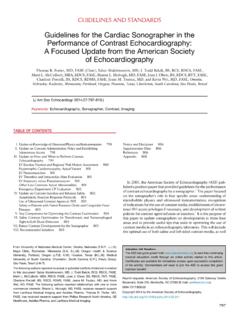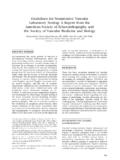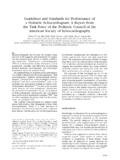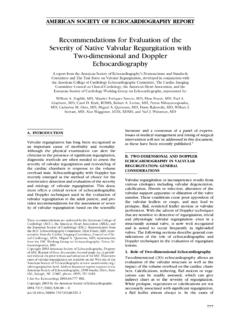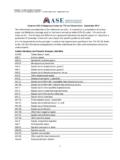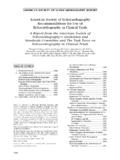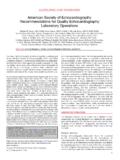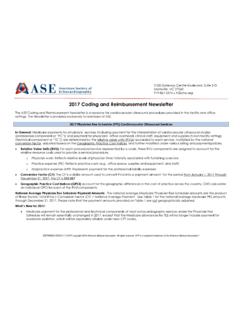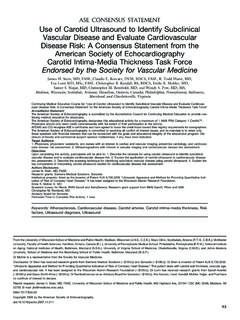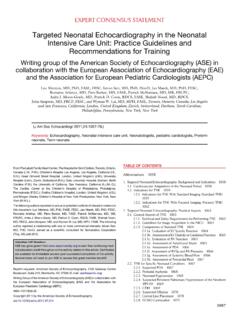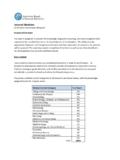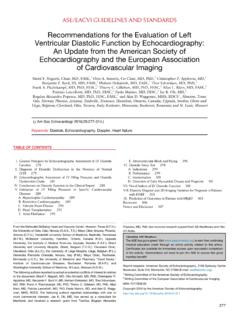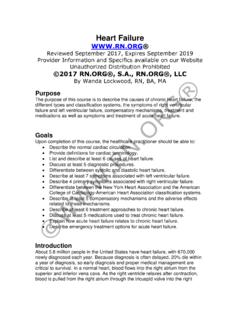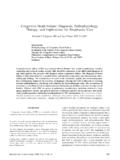Transcription of Recommendations for the Evaluation of Left …
1 GUIDELINES AND STANDARDSR ecommendations for the Evaluation of LeftVentricular Diastolic Function by EchocardiographySherif F. Nagueh, MD, Chair, Christopher P. Appleton, MD, Thierry C. Gillebert, MD,*Paolo N. Marino, MD,* Jae K. Oh, MD, Otto A. Smiseth, MD, PhD,*Alan D. Waggoner, MHS, Frank A. Flachskampf, MD, Co-Chair,*Patricia A. Pellikka, MD, and Arturo Evangelista, MD,*Houston, Texas; Phoenix, Arizona;Ghent, Belgium; Novara, Italy; Rochester, Minnesota; Oslo, Norway; St. Louis, Missouri; Erlangen, Germany;Barcelona, SpainKeywords:Diastole , Echocardiography, Doppler, Heart failureContinuing Medical Education Activity for Recommendations for the Evaluation ofLeft Ventricular Diastolic Function by Echocardiography Accreditation Statement:The American Society of Echocardiography is accredited by the Accreditation Councilfor Continuing Medical Education to provide continuing medical education American Society of Echocardiography designates this educational activity for amaximum of 1 AMA PRA Category 1 Credits.
2 Physicians should only claim creditcommensurate with the extent of their participation in the and CCI recognize ASE s certificates and have agreed to honor the credit hourstoward their registry requirements for American Society of Echocardiography is committed to resolving all conflict ofinterest issues, and its mandate is to retain only those speakers with financial intereststhat can be reconciled with the goals and educational integrity of the educationalprogram. Disclosure of faculty and commercial support sponsor relationships, if any,have been Audience:This activity is designed for all cardiovascular physicians, cardiac sonographers,cardiovascular anesthesiologists, and cardiology :Upon completing this activity, participants will be able to: 1. Describe the hemody-namic determinants and clinical application of mitral inflow velocities. 2. Recognizethe hemodynamic determinants and clinical application of pulmonary venous flowvelocities. 3. Identify the clinical application and limitations of early diastolic flowpropagation velocity.
3 4. Assess the hemodynamic determinants and clinical applica-tion of mitral annulus tissue Doppler velocities. 5. Use echocardiographic methods toestimate left ventricular filling pressures in patients with normal and depressed EF,and to grade the severity of diastolic Disclosures:Thierry C. Gillebert: Research Grant Participant in comprehensive research agree-ment between GE Ultrasound, Horten, Norway and Ghent University; Advisory Board Astra-Zeneca, Merck, following stated no disclosures: Sherif F. Nagueh, Frank A. Flachskampf, ArturoEvangelista, Christopher P. Appleton, Thierry C. Gillebert, Paolo N. Marino, Jae K. Oh,Patricia A. Pellikka, Otto A. Smiseth, Alan D. of interest: The authors have no conflicts of interest to disclose except asnoted time to complete this activity: 1 hourTABLE OF CONTENTSP reface 108I. Physiology 108II. Morphologic and Functional Correlates of Diastolic Dysfunc-tion 109A. LV Hypertrophy 109B. LA Volume 109C. LA Function 110D.
4 Pulmonary Artery Systolic and Diastolic Pressures 110 III. Mitral Inflow 111A. Acquisition and Feasibility 111B. Measurements 111C. Normal Values 111D. Inflow Patterns and Hemodynamics 111E. Clinical Application to Patients With Depressed and Nor-mal EFs 111F. Limitations 112IV. Valsalva Maneuver 113A. Performance and Acquisition 113B. Clinical Application 113C. Limitations 113V. Pulmonary Venous Flow 113A. Acquisition and Feasibility 113B. Measurements 113C. Hemodynamic Determinants 114D. Normal Values 114E. Clinical Application to Patients With Depressed and Nor-mal EFs 114F. Limitations 114VI. Color M-Mode Flow Propagation Velocity 114A. Acquisition, Feasibility, and Measurement 114B. Hemodynamic Determinants 114C. Clinical Application 115D. Limitations 115 VII. Tissue Doppler Annular Early and Late Diastolic Veloci-ties 115A. Acquisition and Feasibility 115B. Measurements 115C. Hemodynamic Determinants 116D. Normal Values 116E. Clinical Application 116F.
5 Limitations 117 VIII. Deformation Measurements 118IX. Left Ventricular Untwisting 118A. Clinical Application 118 From the Methodist DeBakey Heart and Vascular Center, Houston, TX ( );Mayo Clinic Arizona, Phoenix, AZ ( ); the University of Ghent, Ghent,Belgium ( ); Eastern Piedmont University, Novara, Italy ( ); MayoClinic, Rochester, MN ( , ); the University of Oslo, Oslo, Norway( ); Washington University School of Medicine, St Louis, MO ( ); theUniversity of Erlangen, Erlangen, Germany ( ); and Hospital Vall d Hebron,Barcelona, Spain ( ).Reprint requests: American Society of Echocardiography, 2100 Gateway CentreBoulevard, Suite 310, Morrisville, NC 27560 Committee of the European Association of Echocardiography. Writing Committee of the American Society of $ 2009 Published by Elsevier Inc. on behalf of the American Society Limitations 118X. Estimation of Left Ventricular Relaxation 119A. Direct Estimation 1191. IVRT 1192.
6 Aortic Regurgitation CW Signal 1193. MR CW Signal 119B. Surrogate Measurements 1191. Mitral Inflow Velocities 1192. Tissue Doppler Annular Signals 1193. Color M-Mode Vp 119XI. Estimation of Left Ventricular Stiffness 119A. Direct Estimation 119B. Surrogate Measurements 1201. DT of Mitral E Velocity 1202. A-Wave Transit Time 120 XII. Diastolic Stress Test 120 XIII. Other Reasons for Heart Failure Symptoms in Patients WithNormal Ejection Fractions 121A. Pericardial Diseases 121B. Mitral Stenosis 122C. MR 122 XIV. Estimation of Left Ventricular Filling Pressures in Special Pop-ulations 122A. Atrial Fibrillation 122B. Sinus Tachycardia 123C. Restrictive Cardiomyopathy 123D. Hypertrophic Cardiomyopathy 123E. Pulmonary Hypertension 123XV. Prognosis 126 XVI. Recommendations for Clinical Laboratories 127A. Estimation of LV Filling Pressures in Patients With De-pressed EFs 127B. Estimation of LV Filling Pressures in Patients With NormalEFs 127C. Grading Diastolic Dysfunction 128 XVII.
7 Recommendations for Application in Research Studies andClinical Trials 128 PREFACEThe assessment of left ventricular (LV) diastolic function should be anintegral part of a routine examination, particularly in patients present-ing with dyspnea or heart failure. About half of patients with newdiagnoses of heart failure have normal or near normal global ejectionfractions (EFs). These patients are diagnosed with diastolic heartfailure or heart failure with preserved EF. 1 The assessment of LVdiastolic function and filling pressures is of paramount clinical impor-tance to distinguish this syndrome from other diseases such aspulmonary disease resulting in dyspnea, to assess prognosis, and toidentify underlying cardiac disease and its best filling pressures as measured invasively include mean pulmo-nary wedge pressure or mean left atrial (LA) pressure (both in theabsence of mitral stenosis), LV end-diastolic pressure (LVEDP; thepressure at the onset of the QRS complex or after A-wave pressure),and pre-A LV diastolic pressure (Figure 1).
8 Although these pressuresare different in absolute terms, they are closely related, and theychange in a predictable progression with myocardial disease, suchthat LVEDP increases prior to the rise in mean LA has played a central role in the Evaluation of LVdiastolic function over the past two decades. The purposes of thisdocument is to provide a comprehensive review of the techniquesand the significance of diastolic parameters, as well as recommenda-tions for nomenclature and reporting of diastolic data in adults. Therecommendations are based on a critical review of the literature andthe consensus of a panel of PHYSIOLOGYThe optimal performance of the left ventricle depends on its ability tocycle between two states: (1) a compliant chamber in diastole thatallows the left ventricle to fill from low LA pressure and (2) a stiffchamber (rapidly rising pressure) in systole that ejects the strokevolume at arterial pressures. The ventricle has two alternating func-tions: systolic ejection and diastolic filling.
9 Furthermore, the strokevolume must increase in response to demand, such as exercise,without much increase in LA theoretically optimal LVpressure curve is rectangular, with an instantaneous rise to peak andan instantaneous fall to low diastolic pressures, which allows for themaximum time for LV filling. This theoretically optimal situation isapproached by the cyclic interaction of myofilaments and assumescompetent mitral and aortic valves. Diastole starts at aortic valve1020 TIME (ms)0040020 PRESSURE (mmHg)1020 Normal EDPHigh EDPLVLA rapid fillingslow 1 The 4 phases of diastole are marked in relation tohigh-fidelity pressure recordings from the left atrium (LA) and leftventricle (LV) in anesthetized dogs. The first pressure crossovercorresponds to the end of isovolumic relaxation and mitral valveopening. In the first phase, left atrial pressure exceeds left ven-tricular pressure, accelerating mitral flow. Peak mitral E roughlycorresponds to the second crossover.
10 Thereafter, left ventricularpressure exceeds left atrial pressure, decelerating mitral two phases correspond to rapid filling. This is followed byslow filling, with almost no pressure differences. During atrialcontraction, left atrial pressure again exceeds left ventricularpressure. Thesolid arrowpoints to left ventricular minimal pres-sure, thedotted arrowto left ventricular pre-A pressure, and thedashed arrowto left ventricular end-diastolic pressure. Theupperpanelwas recorded at a normal end-diastolic pressure of 8 mmHg. Thelower panelwas recorded after volume loading and anend-diastolic pressure of 24 mm Hg. Note the larger pressuredifferences in both tracings of thelower panel, reflecting de-creased operating compliance of the LA and LV. Atrial contractionprovokes a sharp rise in left ventricular pressure, and left atrialpressure hardly exceeds this elevated left ventricular pressure.(Courtesy of T. C. Gillebert and A.)
